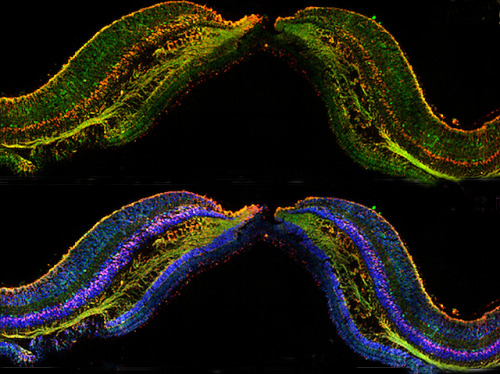
Defence Against Blindness
The eye’s light sensing retina has two distinct regions – the macula, home to neurons that give us detailed sight, and the periphery for side and night vision. Compared to the peripheral retina, the macula is more susceptible to conditions like diabetic retinopathy, and uniquely to age-related macular degeneration, two of the most common causes of vision loss worldwide. Scientists recently looked to the retina’s Müller cells to explain this vulnerability. Found in both the macula and periphery, Müller cells help maintain a stable and functional environment for retinal neurons. The team found that several molecular functions were more active in Müller cells in the human macula (pictured, two cross-sections stained for different Müller cell markers) compared to the periphery. These particular functions are thought to defend the macula from oxidative stress, which could make this sensitive area more susceptible to vision loss. Digging further into Müller cells’ protective role could uncover new treatments for blinding diseases.
Written by Gaëlle Coullon
- Image from work by Ting Zhang and Ling Zhu, and colleagues
- Save Sight Institute, Sydney Medical School, Faculty of Medicine and Health, The University of Sydney, Sydney, Australia
- Image originally published under a Creative Commons Licence (BY 4.0)
- Published in eLife, April 2019
You can also follow BPoD on Instagram, Twitter and Facebook
Archive link





Комментариев нет:
Отправить комментарий